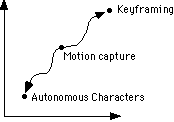|
The animation of bipedal locomotion has long been a topic of fascination to many. Zeltzer [Zel82]
presents a hierarchical task-oriented animation system in which the low-level walking motions are
implemented kinematically, based on measured human data. Girard and Maciejewski [GM85] use
rules associated with dynamics (rather than dynamics simulations) for torso motion and inverse
kinematics for leg motion to generate one of the first non-rotoscoped, natural looking walks. non-rotoscoped, natural looking walks.
Bruderlin and Calvert [BC89] break each step into a number of kinematically-defined subphases
based on known human gait mechanics and use simplified dynamics simulation to generate the
motion in between each subphase. By allowing the user to vary a number of gait determinants, a
wide variety of natural-looking walks can be generated. Since in this approach, the dynamics are
highly constrained, replacing the dynamic interpolation with kinematic interpolation [BC93] is
found to give results of similar quality while increasing performance significantly, allowing gait
parameters to be adjusted interactively. This work currently represents the state-of-the-art in real-
|

 1
2
3
4
5
6
7
8
9
10
11
12
13
14
15
16
17
18
19
20
21
22
23
24
25
26
27
28
29
30
31
32
33
34
35
36
37
38
39
40
41
42
43
44
45
46
47
48
49
50
51
52
53
54
55
56
57
58
59
60
61
62
63
64
65
66
67
68
69
70
71
72
73
74
75
76
77
78
79
80
81
82
83
84
85
86
87
88
89
90
91
92
93
94
95
96
97
98
99
100
101
102
103
104
105
106
107
108
109
110
111
112
113
114
115
116
117
118
119
120
121
122
123
124
125
126
127
128
129
130
131
132
133
134
135
1
2
3
4
5
6
7
8
9
10
11
12
13
14
15
16
17
18
19
20
21
22
23
24
25
26
27
28
29
30
31
32
33
34
35
36
37
38
39
40
41
42
43
44
45
46
47
48
49
50
51
52
53
54
55
56
57
58
59
60
61
62
63
64
65
66
67
68
69
70
71
72
73
74
75
76
77
78
79
80
81
82
83
84
85
86
87
88
89
90
91
92
93
94
95
96
97
98
99
100
101
102
103
104
105
106
107
108
109
110
111
112
113
114
115
116
117
118
119
120
121
122
123
124
125
126
127
128
129
130
131
132
133
134
135

